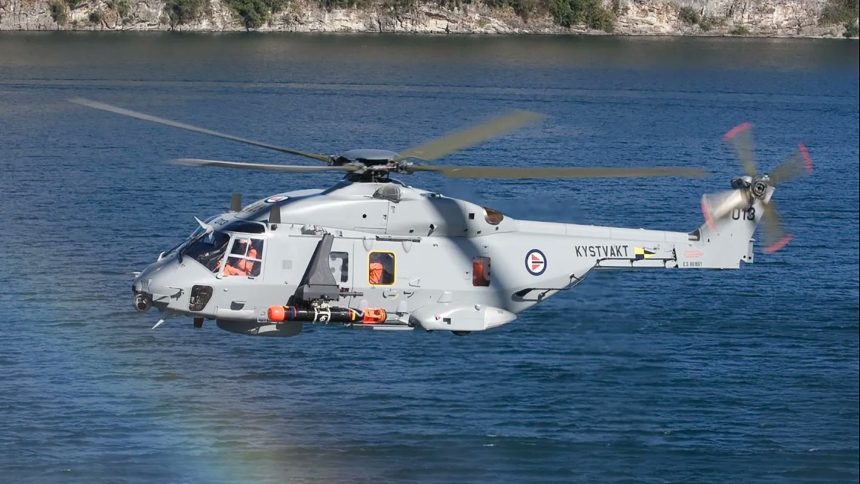The Norwegian government and NHIndustries reached an agreement to settle the dispute related to Norway’s NH90 program, after its termination in 2022.
The Norwegian government and NHIndustries announced on Nov. 3, 2025 that they resolved their court dispute over the NH90 helicopter with an amicable settlement, three years after the country canceled the contract with the firm. The helicopter served with the Norwegian Armed Forces for nearly 20 years, but had been afflicted with acute maintainability issues.
The joint statement said that the amicable settlement solved “all disputes between the parties relating to the Norwegian NH90 program.” The statement further says that, “as a result of the settlement, all court proceedings between the parties are now concluded.”
Following the settlement at the Oslo district court, NHI will take back and “assume full control” of all “helicopters, associated spare parts, tools, and mission-specific equipment” from the Norwegian government. The company will “reintegrate them within the NH90 program, making in-demand parts and equipment available to other users of the NH90.”
NHI has also agreed to pay the Norwegian government EUR 305 millions, along with EUR 70 million which include amounts previously paid pursuant to bank guarantees. “This solution reflects the parties’ mutual agreement to bring all related disputes to a conclusive end,” the statement explained.
🚁🇳🇴 Settlement concerning the Norwegian #NH90-program @NHIndustriesSAS https://t.co/vAuNFn5CHL pic.twitter.com/EhMJw4rmgb
— Philippe Top-Action (@top_force) November 3, 2025
Norway and its NH90s
The Norwegian government had announced the termination of the contract on Jun. 10, 2022, and halted all operations with the NH90. The country operated the NH90 for 20 years and cited delays with acquiring spares, components, recurring maintenance issues and poor availability rates. It had also sought a full refund of $522 million from NHIndustries.
Norway joined the programme in 2001, ordering 14 helicopters for Coast Guard and Anti-Submarine Warfare duties, originally slated for delivery by the end of 2008. However, at the time of the contract termination, NHI delivered only eight helicopters in a fully operational configuration.
These helicopters were expected to provide 3,900 flight hours annually. However, the MoD reported at the time their mission availability was only a fifth of that, with a total of about 700 hours.
The largest military helicopter program in Europe, the NH90 has two main variants – the NH90 NFH (NATO Frigate Helicopter) for naval operations and the TTH (Tactical Transport Helicopter) for land-based operations. It is manufactured by NHIndustries, a Joint Venture between Airbus Helicopters (62.5%), Leonardo (32%) and GKN Fokker (5.5%).

Around 490 NH90 helicopters, a mix of both variants, are in service worldwide. Despite the persistent problems, the helicopter continues to evolve. Specifically, Airbus is testing the NH90 Special Operations Forces prototype, and NHIndustries launched the development of the Block 1 variant in June 2024.
In 2023, Norway also announced the selection of six U.S.-made Sikorsky MH-60 Seahawk to replace the NH90s in the ASW (Anti-Submarine Warfare) role. Deliveries started this year, and are planned to be completed in 2027.
Contract termination
In the Jun. 10, 2022, announcement of the termination of the contract with NHIndustries, the director of Defence Materiel Gro Jære said: “We have repeatedly tried to solve the problems in collaboration with the supplier, but more than 20 years after the contract was signed, we are still without helicopters that can do the job they were purchased for, and without the supplier being able to present realistic solutions to the problems.”
A “comprehensive evaluation” by the Norwegian Armed Forces, Norwegian Defence Materiel Administration and the Norwegian Defence Research Institute found that “even with large additional investments it will not be possible to increase this to a level that meets the needs of the Norwegian Armed Forces.”

“This is the right decision for the NH90 and the maritime helicopter capacity. This was also our recommendation,” said Chief of Defence Eirik Kristoffersen in the press release. “It is not about a lack of effort, creativity and expertise, but solely about the fact that we have been given a helicopter that has not delivered operationally,” Kristoffersen added.
Other NH90 users and problems
Besides Norway, the NH90 is also used by Australia, Belgium, Sweden, France, the Netherlands, Greece, Italy, Germany, Spain, Oman, Qatar and New Zealand. Nearly each one has reported a similar set of issues with the aircraft.
Dette blir NH90-helikoptrenes nye base på Haakonsvern. https://t.co/maaMRkk7my pic.twitter.com/e2P5M2oQ0L
— Norwegian Armed Forces | Forsvaret (@Forsvaret_no) September 29, 2016
July saw Belgium’s Minister of Defence Theo Francken announcing the retirement of its four NH90 TTHs, but the four NH90 NFHs will continue to be used. “The four NH90 TTH helicopters will be taken out of service starting in September. Bad purchase. Extremely expensive to maintain. Replacements are coming in 2026,” Francken said on X.
The Belgian MoD in June 2024 also ordered 15 Airbus Helicopters H145Ms, which will succeed the NH90 TTHs and replace the Belgian Air Component’s 10 remaining AgustaWestland AW109 helicopters, which have been in service since 1992. The H145M deliveries are scheduled to begin in 2026.
Australia’s case with its NH90s is even more famous, operating 46 airframes, locally designated MRH-90 Taipan (Multi-Role Helicopter). They had been in service since 2008, and the fleet of 46 Taipans was retired a decade ahead of schedule.
The helicopters had experienced a series of engine failures and maintenance issues, leading to the decision. In August 2022, Canberra approved the purchase of 40 UH-60M Black Hawks to replace the Taipan.
Forsvaret har fått sitt første NH90 med sonar, som dermed kan jakte på ubåter.https://t.co/ozW9mWcF7i pic.twitter.com/x7r02alyJ4
— Norwegian Armed Forces | Forsvaret (@Forsvaret_no) February 9, 2016
Finland too had reported low availability rates, between 19% to 40%, of its 20 NH90 TTHs for the Army, meant to replace the Russian Mil Mi-8s. However, Italy, Germany, the Netherlands, Spain and France have reported little issues with their NH90s. Madrid in September 2018 approved the purchase of 23 additional NH90 TTHs.









